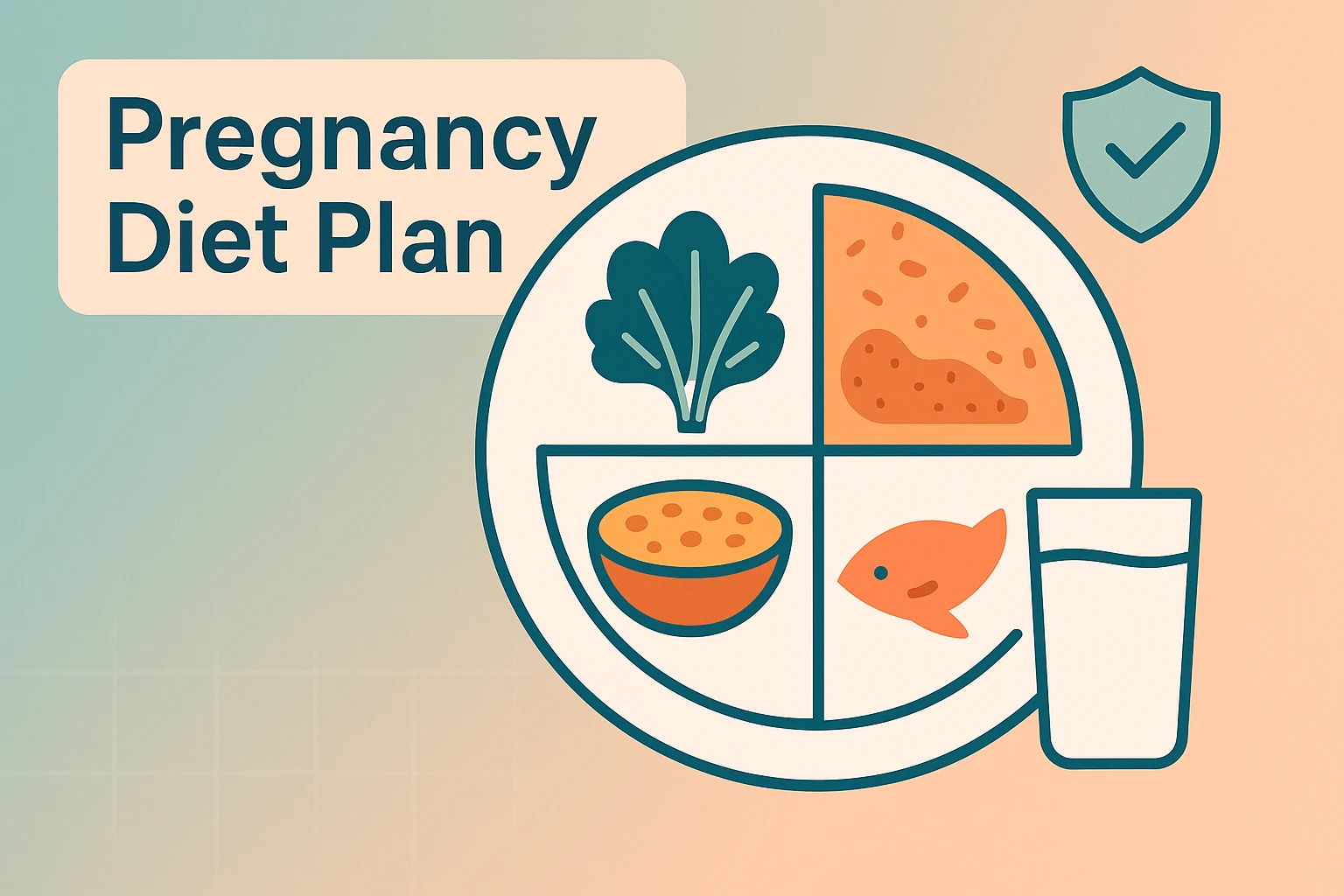Growing a baby is extraordinary—and it’s hungry work. The right pregnancy diet plan does not mean “eating for two” or counting every bite; it means building balanced plates, getting enough of the nutrients that matter most, and staying food-safe. This guide translates global recommendations into everyday Indian meals so you can nourish yourself confidently through all three trimesters.
Educational only, not medical advice. For personalised guidance—especially if you have conditions like anaemia, thyroid issues, PCOS, or gestational diabetes—please speak with your obstetrician and a registered dietitian.
Why your diet matters in pregnancy
A thoughtful diet supports your baby’s brain, bones, and immune system while keeping your energy up and preventing deficiencies (like iron deficiency anaemia). Key nutrients with increased needs include protein, iron, folate/folic acid, iodine, choline, calcium, vitamin D and fibre. Health.govOffice of Dietary Supplements
Well-planned vegetarian or non-vegetarian diets can both meet pregnancy needs—what matters is variety and balance. India’s new ICMR–NIN Dietary Guidelines (2024) recommend sourcing your daily nutrition from at least eight food groups with plenty of vegetables, fruits, pulses/legumes, dairy, whole grains/millets, nuts/seeds and healthy fats. ICMR-National Institute of Nutrition
How much to eat: calories and weight gain
You don’t need extra calories in the first trimester. In the second trimester, most people need around +340 kcal/day, rising to +450 kcal/day in the third—think an extra katori of dal, a fruit-and-curd bowl, or a peanut chikki and a glass of milk rather than a whole extra meal. ACOG
Healthy weight gain targets (singleton pregnancy)
Your ideal weight gain depends on your pre-pregnancy BMI. These ranges come from the Institute of Medicine (IOM) and are endorsed in obstetric practice:
- Underweight (BMI <18.5): 12.5–18 kg
- Normal (18.5–24.9): 11.5–16 kg
- Overweight (25–29.9): 6.8–11.3 kg
- Obesity (≥30): 5–9 kg ACOGMSD ManualsPMC
Gaining within these ranges is associated with better outcomes for you and your baby. If nausea or food aversions make weight gain hard early on, prioritise nutrient-dense small meals and discuss options with your clinician.
The “3–2–1” pregnancy plate (easy daily template)
- 3 parts vegetables & fruit (aim for 2+ cups veg and 1–2 fruits/day; mix colours)
- 2 parts quality protein (dals/beans/chana/rajma, curd/paneer, eggs, fish or chicken)
- 1 part whole grains or millets (roti, brown rice, jowar, bajra, ragi, poha, daliya)
- Plus dairy (or fortified alternatives), healthy fats (groundnut, mustard, sesame, olive oil), and plenty of water
This aligns with ICMR–NIN’s “My Plate for the Day” diversity emphasis and keeps portions practical for Indian meals. ICMR-National Institute of Nutrition
Nutrient priorities (with Indian food sources)
Protein
Builds baby’s tissues and your expanding blood volume.
Good sources: dals, chana, rajma, soy/tempeh/tofu, paneer, curd, eggs, fish, chicken, nuts and seeds. Include protein at each meal for better appetite control and steady energy. Health.gov
Iron
Prevents anaemia, fatigue and supports baby’s brain development.
Plant sources: rajma, chole, masoor, moong, soy, spinach, methi, garden cress seeds (halim/alsi), jaggery, sesame.
Animal sources: eggs (yolk), chicken, mutton, fish.
Tip: Pair with vitamin C (lemon, amla, guava) to boost absorption; avoid tea/coffee with iron-rich meals. Better Health Channel
Folate/folic acid
Crucial for early neural development.
Foods: dark leafy greens, beans, citrus, beetroot, avocado, fortified cereals. Supplementation is routine—use only what your clinician prescribes (no self-dosing). Health.gov
Iodine
Supports baby’s brain and thyroid development.
Foods: iodised salt (use sparingly but consistently), dairy, eggs, fish; some breads are iodised. Vegetarians should be deliberate about iodised salt use. Health.gov
Choline
Often missed but vital for brain development.
Foods: eggs (especially yolk), soy, rajma/chana, peanuts, cauliflower. Office of Dietary Supplements
Calcium & Vitamin D
For bones and teeth; vitamin D helps absorb calcium.
Foods: milk/curd/paneer, ragi, til (sesame), almonds, amaranth (rajgira), small fish with bones (e.g., anchovies). Sunlight exposure helps vitamin D; supplements only under medical advice. Health.gov
Omega-3 (DHA)
Supports brain and eye development.
Foods: oily fish (salmon, sardines, mackerel), walnuts, chia, flaxseed. If you avoid fish, talk to your doctor about algal DHA supplements—dose as prescribed. U.S. Food and Drug Administration
Fibre & fluids
Help prevent constipation and stabilise blood sugars.
Foods: vegetables, whole fruits, whole grains/millets, pulses, nuts and seeds; sip water regularly (urine should be pale straw coloured).
Fish and seafood: how much, which ones
Fish is rich in protein, iodine and omega-3s—but mercury matters. Choose low-mercury fish 2–3 times/week (about 8–12 oz or 224–340 g total per week), such as salmon, sardines, anchovies, tilapia, catla/rohu (carp), Indian mackerel, or shrimp. Avoid large predatory fish like shark, swordfish and certain big tuna species; if you eat tuna, prefer canned “light” (skipjack). Always cook seafood thoroughly. U.S. Food and Drug Administration
India’s food regulator also sets limits for contaminants like methylmercury; the principle remains to limit high-mercury species while enjoying a variety of low-mercury fish. FSSAI
What to limit or avoid (food safety first)
Pregnancy temporarily changes your immune response, so some foods carry a higher risk.
- Unpasteurised milk and soft cheeses made from raw milk (e.g., some artisanal paneer/cheeses); choose pasteurised dairy. CDCnhs.uk
- Raw or undercooked eggs/meat/seafood (no runny eggs unless standards ensure safety; no sushi/sashimi/raw oysters). Cook fish to 63 °C and poultry to 74 °C. FoodSafety.gov
- Deli meats/cold cuts, unless steaming hot (heat to 74 °C/165 °F). CDC
- Refrigerated pâtés, live,r and liver products (excess vitamin A risk). Tommy’sNHS Inform
- Unwashed produce; rinse thoroughly and practise kitchen hygiene. U.S. Food and Drug Administration
- Alcohol: the consensus is clear—no known safe amount at any time in pregnancy; the safest choice is to avoid alcohol altogether. CDCACOGNIAAA
- Caffeine: keep to <200 mg/day (about one 350 ml cup of brewed coffee; chai has less, but totals add up with cola/energy drinks/chocolate). ACOG
If you develop fever, vomiting/diarrhoea, severe abdominal pain, or notice reduced fetal movements later in pregnancy, contact your care team urgently.
Trimester-by-trimester tips
First trimester (0–13 weeks)
- Prioritise folate-rich foods, gentle hydration, and small, frequent meals to ease nausea.
- Dry snacks (khakra, toast), ginger/lemon, and plain curd can help.
- Keep food safety tight—Listeria risk, though low, is serious in pregnancy. ACOG
Second trimester (14–27 weeks)
- Appetite often improves—add that ~340 kcal/day via nutrient-dense snacks: fruit + nut butter, chana chaat, cheese and wholegrain crackers, or a ragi dosa with sambar. ACOG
- Focus on iron + vitamin C pairs (e.g., palak–corn roti with lemon; rajma–brown rice with kachumber).
Third trimester (28–40 weeks)
- You’ll need ~450 extra kcal/day and more fluid/fibre to prevent constipation and reflux (smaller meals, avoid lying down right after eating). ACOG
- Keep protein at every meal for steady energy and tissue repair. Health.gov
Special scenarios (brief notes)
- Vegetarian/vegan: Pay attention to protein, iron (plus vitamin C), vitamin B12 (from dairy/eggs or fortified foods; discuss supplements), iodine (iodised salt), choline (eggs/soy/legumes), and omega-3 (walnuts, flax/chia; consider algal DHA under medical advice). Office of Dietary Supplements
- Gestational diabetes (GDM): Use a plate method (½ non-starchy veg, ¼ protein, ¼ whole grains/millets), spread carbohydrates across meals and snacks, and pair carbs with protein/fat. Individualise with a dietitian; monitor sugars as advised.
- Anaemia: Emphasise iron-rich foods + vitamin C and follow prescribed iron supplements; manage side-effects with your clinician’s help.
- Nausea/aversion: Choose cold or room-temperature foods, smoothies, or nutrient-dense mini-meals.
A simple 1-day Indian meal plan (2,100–2,300 kcal)
Adjust portions to your hunger, activity, trimester and clinician’s advice.
Early morning
- Warm water; a handful of soaked almonds + 1 small banana
Breakfast
- 2 ragi dosas with ghee + sambar (lots of vegetables)
- 1 bowl plain curd
Mid-morning
- Guava slices with chaat masala + lemon (vitamin C for iron absorption)
Lunch
- 2 phulkas (whole wheat/jowar mix)
- Palak chana (spinach + chickpea curry)
- Kachumber salad (cucumber, tomato, onion, lemon)
- A small bowl of curd (or buttermilk)
Evening snack
- Roasted chana & peanuts trail mix
- Coconut water (electrolytes)
Dinner
- Brown rice (or millet khichdi)
- Rajma masala (or grilled fish like Indian mackerel if non-veg)
- Stir-fried seasonal veg (bhindi/beans/carrot)
- Warm haldi milk (pasteurised) or fortified soy milk
Optional night snack
- 1 fruit (orange/pear) or a small peanut chikki
This plan distributes protein, iron, fibre and calcium across the day while staying taste-friendly and realistic.
Your smart shopping list
- Vegetables & fruits: dark leafy greens (palak, methi, amaranth), carrot, beetroot, bhindi, beans, gourds, tomatoes, citrus, amla, guava, banana, pomegranate, seasonal berries.
- Grains & millets: whole wheat atta, brown rice, poha, daliya, jowar, bajra, ragi.
- Proteins: mixed dals (toor, masoor, moong, urad), chana/rajma, soy chunks/tofu, paneer, curd, eggs, fish (low-mercury), chicken.
- Healthy fats: groundnut, mustard, sesame or olive oil; nuts (almonds, walnuts), seeds (flax, chia, til).
- Add-ons: iodised salt, spices (jeera, haldi, hing, ajwain), lemon, jaggery, cocoa, and herbal teas that are pregnancy-safe (ask your clinician).
Eating out or ordering in—practical rules
- Choose freshly cooked dishes; avoid buffets and long-held foods.
- Go for grilled/roasted/steamed over deep-fried.
- Ask for whole-wheat options (rotis, wraps) and extra vegetables.
- Skip raw salads outside trusted places; opt for cooked veg instead.
- No alcohol, and watch caffeine totals for the day. CDCACOG
Hydration and digestion
Aim for regular sips through the day—plain water, infused water, fresh lime (nimbu) without excessive sugar, thin buttermilk, or coconut water. For constipation: fibre + fluids + activity (as approved by your doctor) usually helps; prunes and soaked raisins can be gentle supports.
Supplements: use only as prescribed
Most pregnant people are advised to take folic acid (preconception/early pregnancy), iron, calcium/vitamin D, and sometimes iodine or DHA, depending on diet and blood tests. Do not self-prescribe or adjust doses—use exactly what your clinician recommends and what official labels indicate. Evidence for herbal/botanical supplements is mixed; discuss any product before use. Office of Dietary Supplements
Food safety checklist (pin this!)
- Wash hands, boards, knives; keep raw and cooked separate.
- Cook meats/seafood thoroughly; reheat leftovers to steaming hot.
- Avoid unpasteurised dairy and raw sprouts.
- Eat ready-to-eat foods promptly; keep the fridge ≤4 °C. U.S. Food and Drug Administration
When to seek care (red flags)
Call your doctor if you have persistent vomiting, signs of dehydration (very dark urine, dizziness), fever, severe abdominal pain, bloody diarrhoea, foul-smelling vaginal discharge, or reduced fetal movements later in pregnancy. Timely care protects both you and your baby.
Eating well in pregnancy is less about perfection and more about consistent, nourishing choices. Build balanced plates, include iron- and iodine-rich foods, enjoy low-mercury fish if you eat seafood, stay caffeine-aware, and follow food safety. With a little planning, Indian home cooking can deliver everything you and your baby need.
A balanced pregnancy diet is achievable, enjoyable, and profoundly impactful. Focus on variety, whole foods, and smart safety steps, and personalise with your clinician’s advice—especially if you’re vegetarian, managing GDM, or dealing with anaemia or thyroid conditions.




